Discoveries
Common tern & Roseate tern DISCOVERIES
During the daily checks of the island field assistants made a number of discoveries described in papers in the bibliography. In 1970 team members found abnormal young in the colony and when Robert W. Risebrough, currently Executive Director of the Bodega Bay Institute of Pollution Ecology, Berkeley, CA, analyzed them, levels of PCB’s were higher than either DDT or Mercury. Risebrough analyzed a sample of bait fish as well and found levels of PCB’s in the bait fish were similar to those found in the terns. Bait fish are food for sport fish which in turn are food for humans. The abnormal young found in the colony on Great Gull Island provided the first evidence PCB’s could affect a wild population and served as an early warning of their presence in fish which could affect humans as well as terns.

Work in South America & Azores
In 1995 Hays obtained funding for a team to begin searching for Roseate Terns along the coast of South America. No researchers at this time knew where Roseate Terns spent the nonbreeding season. The team included: Grace Cormons, who works on Roseate Terns on Great Gull Island, Peter Cormons, Grace’s son, Joseph DiCostanzo, data manager and analyst for the Great Gull Island Project, Helen Hays and Mauricio Calvo, driver/translator.
The team started in Argentina at Punta Rasa where they found a large concentration of Common Terns, and met Esteban Bremer from the Fundacion Vida Silvestre Argentina, an Argentinean conservation organization. Esteban was netting and banding terns at Punta Rasa. Today the Great Gull Island Project has a cooperative project with Esteban in which project members help with netting in Argentina and Esteban brings field assistants from Argentina to help during the peak hatch on Great Gull Island. Esteban has done this since 2000 and it has been an invaluable asset for the Great Gull Island program.
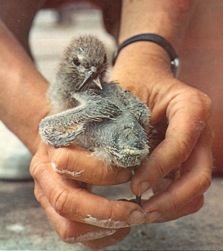
Roseate Juvenile with crossed bill
In addition to terns from Great Gull Island, Pedro netted a number of Common Terns from the Azores at Mangue Seco. This raised the question of whether Roseate Terns from the Azores might also cross the Atlantic and be at Mangue Seco during the nonbreeding season.
To answer this Matt Cormons, Grace’s husband, went to the Azores in 1999. There, he and Veronica Neves, an Azorean sea bird expert, initiated a Roseate Tern trapping project. They were assisted in different years by Talvi Ansel, Joel Bried, Grace Cormons, Peter Cormons, Cristina Nava and Maria Magalhães. Fishermen: Luis Gomez (Maré Boa) from Terceira Island and the skippers Carlos Toste from Flores and Sr. Zé Maria and Marko from Santa Maria made the, often somewhat difficult access to the islands, possible.
During their study the Azores team recovered two Roseate Terns originally banded at Mangue Seco, and Pedro recovered two Roseate Terns originally banded in the Azores. Additionally they trapped a Roseate Tern wearing two plastic bands, but no metal band. Plastic bands like these had only been used to band adult Roseate Terns nesting in colonies in the northeastern U.S. and the east coast of Canada. This bird suggests the possibility that individual Roseate Terns sometimes nest in colonies on both sides of the Atlantic. Therefore, there could be gene flow between the eastern and western Atlantic populations.
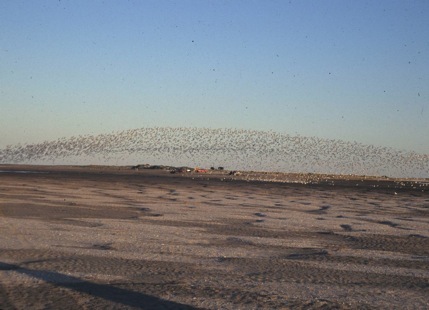
Common Terns at Punta Rasa, Argentina
Conservation Project
In 2007 the Gull Island team, with Pedro Lima and Alberto Campos did a preliminary survey of the coast of Ceara. Team members noticed that fishermen in one of the villages on the coast wore necklaces made of strings of tern bands. Alberto offered to undertake an educational program in the village where the fishermen lived and asked Vinicius Lima from Aquasis to work with the villagers, explaining why the terns wore the bands and why it was important to protect them.
Vinicius learned from the villagers they wanted to have a regatta in which they raced the model boats they made for their children, to teach them how to sail. Vinicius helped them organize the regatta and it was a great success. For the second year of the regatta the villagers added a beach clean up. The third year the ladies in the village requested they have a race with laundry on their heads, which they did. The villagers that year decided to call the celebration “The Tern Festival”. In 2010 they added ancient dances to the festival program and in 2012 the men in the village plan to race their fishing boats. Vinicius feels the fishermen in the village are no longer taking bands.

Ready for take off
Geolocators
The Great Gull Island team located three places in Brazil, in addition to Mangue Seco where both Common and Roseate Terns concentrated and one large concentration of Common Terns at Punta Rasa in Argentina. However, they knew nothing about the timing of the migrations or the routes the birds took during migration. In order to answer these questions for Common Terns they put geolocators on this species on Great Gull Island in 2009, recovering some of them there in 2010 and 2011. Joe DiCostanzo is working on an analysis of the data he downloaded from the geolocators. James Fox, formerly of British Antarctic Survey where the geolocators were made and at present with Migrate Technology, downloaded data from recovered locators in which the batteries had stopped working.

The terns netted with Pedro at Mangue Seco demonstrated for the first time a regular trans-Atlantic movement for both Roseate and Common Terns and documented that at least some Roseate Terns from northeastern US, the Caribbean and Europe spend the nonbreeding season in the same roosts on the east coast of Brazil. The netting data also showed that Common Terns from northeastern US, Europe and Bermuda can be found during the nonbreeding season in roosts on the east coast of Brazil.
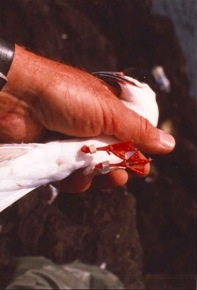
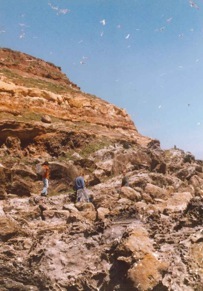
Rocky heights where Roseates nest in the Azores dwarf the trappers
Adult Roseate Tern with only two plastic bands
Radio tagging
In both Argentina and Brazil many more birds come into the roosts at dusk than are at these sites during the day. At Mangue Seco, in Brazil, this was particularly true as there were no terns there during the day. In order to find terns along the coast after they left their roosts Tom Cormons, working in Brazil with Pedro Lima, put radio tranmitters on Roseate and Common Terns at Mangue Seco, working with Leandro Bugoni he put them on Common Terns in Rio Grande do Sul. Esteban Bremer and his team put transmitters on Common Terns in Argentina. Tom then searched for these birds along the shore using the hand held antenna, next working from a boat, he lashed the antenna to the top of boat’s mast. Finally, using a plane, he attached antennas to the wing struts on either side of the plane to pick up signals from birds leaving the roosts (paper in preparation).
Racing with laundry
HELP US KEEP THE TERNS FLYING!
If you would like to volunteer and or support the project, e-mail me. I would be happy to answer any questions you have!
Helen Hays
Origins of banded Roseate Terns (Sterna dougallii) recovered at Mangue Seco, Brasil.
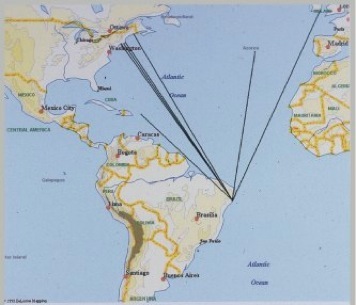
Field assistants on Great Gull Island discovered: hybrids between Common and Roseate Terns; saw both species bringing in multiple fish in their bills; found Common Terns initiating multiple nests; and found a nest where a male and two female Roseates raised three young.
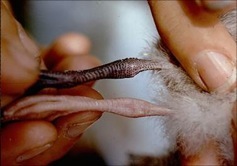
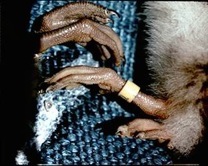
Comparing black leg of Roseate chick with pink leg of Common chick
Hybrid chicks have brown legs
Adult trapping data from Great Gull Island established an age record for Common Terns of 28 years and netting data from Pedro Lima at Mangue Seco documented an age record for Roseate Terns of 25.6 years.
Under Joseph DiCostanzo’s careful processing of the Common Tern adult trapping and banding data, over 600,000 records are computerized and will be submitted shortly to a capture/recapture analysis.
In southern Bahia, off Alcobaça, they found a concentration of Roseate and Common Terns feeding 11 km from shore, providing the first evidence that Roseate Terns spent the nonbreeding season along the South American coast. That same year, Pedro Lima, a veterinary and enthusiastic netter captured Roseate Terns originally banded on Great Gull Island at Mangue Seco, Brazil. When Hays received his recovery records from the banding lab in 1996, she wrote Pedro immediately and asked him if the Great Gull Island team could work with his Brazillian team and net with them at Mangue Seco in 2007. Pedro agreed and the two teams have worked together ever since.
Copyright © 2011 Helen Hays